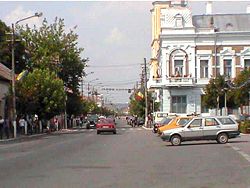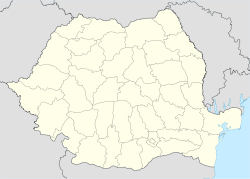- Gherla
-
Gherla — Municipality — Location on Romania map Coordinates: 47°1′12″N 23°54′0″E / 47.02°N 23.9°ECoordinates: 47°1′12″N 23°54′0″E / 47.02°N 23.9°E Country  Romania
RomaniaCounty  Cluj
ClujStatus Municipality Government – Mayor Ovidiu Ioan Drăgan (Democratic Party) Area – Total 36.3 km2 (14 sq mi) Population (July 1, 2007)[1] – Total 22,108 – Density 609/km2 (1,577.4/sq mi) Time zone EET (UTC+2) – Summer (DST) EEST (UTC+3) Website http://www.gherla.ro/ Gherla (Romanian pronunciation: [ˈɡerla]; Armenian: Հայաքաղաք Hayakaghak, German: Neuschloss or Armenierstadt, Hungarian: Szamosújvár or Örményváros) is a city in Cluj County, Romania (in the historical region of Transylvania). It is located 45 km from Cluj-Napoca on the Someşul Mic River, and has a population of 24,083.
Three villages are administered by the city: Băiţa (formerly Chirău, and Kérő in Hungarian), Hăşdate (Szamoshesdát) and Silivaş (Vizszilvás).
Contents
History
The locality was first recorded in 1291, as a village named Gherlahida (probably derived from the Slavic word grle, meaning "ford"). The second name was Armenian, Հայաքաղաք Hayakaghak, meaning "Armenian city"; it gave the Medieval Latin and Greek official name Armenopolis, as well as the German alternative name Armenierstadt. Later, the name of Szamosújvár was used in official Hungarian records, meaning "the new town on the Someş". Before 1918, Gherla was part of the Kingdom of Hungary comitatus of Szolnok-Doboka. It was again part of Hungary between 1940-1944.
The modern city was built in the early 18th century by Armenians, successors of the Cilician Armenian diaspora who had originally settled in Crimea and Moldavia and moved to Transylvania sometime after 1650. After a two years' campaign on the part of the Armenian-Catholic Bishop Oxendius Vărzărescu, they converted from the Armenian Apostolic Church to the Armenian Catholic Church.
Gherla is the seat of the Roman Catholic-led Armenian Rite Gherla Vicariate as well as that of a Greek-Catholic diocese – the Cluj-Gherla Diocese (suffragan to the Greek-Catholic Archbishop of Alba Iulia and Făgăraş-Blaj, who resided in Blaj). In the center of the city lie the Saint Gregory the Illuminator and the Holy Trinity Armenian Cathedral. The main Armenian-Catholic church was built in 1792. The Greek Catholic diocese was created through the Papal Bull Ad Apostolicam Sedem of November 26, 1853, and the first bishop was Ioan Alexi.
A Habsburg fortress was built here, and in 1785 it was transformed into a prison which, during the Communist regime, was used for political detainees (see Gherla prison). Today it is one a high-security prison in Romania.
The town is often visited by Orthodox pilgrims on their way to the nearby village of Nicula and Nicula Monastery.
Population
According to the last Romanian census from 2002 there were 24,083 people living within the city as follows:[2]
- 19,243 (79.9%) Romanians
- 4,086 (16.96%) Hungarians
- 657 (2.72%) Roma
- 97 (0.4%) others, including 31 Armenians and 30 Germans
References
- ^ "Population as of July 1, 2007" (in Romanian). INSSE. April 4, 2008. http://www.insse.ro/cms/rw/resource/populatia_stab_1%20iulie2007.htm. Retrieved 2008-05-04.
- ^ http://www.edrc.ro/recensamant.jsp?regiune_id=2140&judet_id=2295&localitate_id=2299
External links
- Armenierstadt
 This article incorporates text from a publication now in the public domain: Herbermann, Charles, ed (1913). Catholic Encyclopedia. Robert Appleton Company.
This article incorporates text from a publication now in the public domain: Herbermann, Charles, ed (1913). Catholic Encyclopedia. Robert Appleton Company. - Armenians in Romania at the Central European University site
Cluj County, Romania Cities Cluj-Napoca (county seat) · Câmpia Turzii · Dej · Gherla · Turda

Towns Communes Aghireşu · Aiton · Aluniş · Apahida · Aşchileu · Baciu · Băişoara · Beliş · Bobâlna · Bonţida · Borşa · Buza · Căianu · Călăraşi · Călăţele · Cămăraşu · Căpuşu Mare · Căşeiu · Cătina · Câţcău · Ceanu Mare · Chinteni · Chiuieşti · Ciucea · Ciurila · Cojocna · Corneşti · Cuzdrioara · Dăbâca · Feleacu · Fizeşu Gherlii · Floreşti · Frata · Gârbău · Geaca · Gilău · Iara · Iclod · Izvoru Crişului · Jichişu de Jos · Jucu · Luna · Măguri-Răcătău · Mănăstireni · Mărgău · Mărişel · Mica · Mihai Viteazu · Mintiu Gherlii · Mociu · Moldoveneşti · Negreni · Pălatca · Panticeu · Petreştii de Jos · Ploscoş · Poieni · Râşca · Recea-Cristur · Săcuieu · Sănduleşti · Săvădisla · Sâncraiu · Sânmartin · Sânpaul · Sic · Suatu · Tritenii de Jos · Tureni · Ţaga · Unguraş · Vad · Valea Ierii · Viişoara · Vultureni
Categories:- Populated places in Cluj County
- Cities in Romania
- Armenian diaspora communities
Wikimedia Foundation. 2010.


